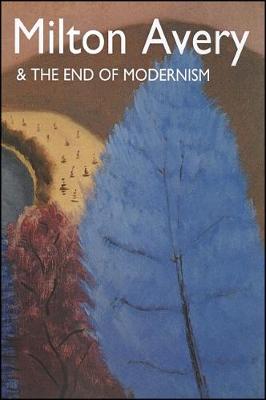Samuel Dorsky Museum of Art
1 total work
"I try to construct a picture in which shapes, spaces, colors, form a set of unique relationships, independent of any subject matter. At the same time I try to capture and translate the excitement and emotion aroused in me by the impact with the original idea." — Milton Avery
Milton Avery and the End of Modernism looks at work by the artist who brought the sketch, with its spontaneity, movement, and fleetingness, to the status of a finished painting. The works reproduced in this exhibition catalog feature Avery's intense saturated color fields, the simplification of form, and figures that emphasize the flatness of canvas surface.
In the four chapters that open the catalog, Karl Emil Willers takes a concerted look at the contributions of Milton Avery as a significant figurative painter from the late 1920s through the early 1960s, and at the development of Avery's signature paintings from his idiosyncratic drawing style that captures the essence of a person, place, or time. Placing Avery's work within a long history of modernist practice that recognizes the artist's sketch as a "final, complete and a self-sufficient work of art," Willers argues that, within the emergence of his avant-garde style, Avery can be seen as one of the preeminent American painters of his time, exerting great influence among both his contemporaries and subsequent generations of artists.
Regarding Avery's place in American art history, Patterson Sims has written: "Early in Avery's career, when Social Realism and American Scene painting were the prevailing artistic styles, the semi-abstract tendencies in his work were viewed by many as too radical. In the 1950s, a period dominated by Abstract Expressionism, he was overlooked by critics because of his adherence to recognizable subject matter. Nevertheless, his work, with its emphasis on color, was important to many younger artists, particularly to Mark Rothko, Adolph Gottlieb, Barnett Newman, Helen Frankenthaler, and other Color Field painters."
Milton Avery and the End of Modernism opened at the Nassau County Museum of Art on January 22, 2011, and remained on view through May 8, 2011. It was organized by Director Karl Emil Willers and the Neuberger Museum of Art, Purchase College, State University of New York. It was funded, in part, by the New York State Council for the Arts, the Friends of the Neuberger Museum of Art, and the Westchester Arts Council.
Milton Avery and the End of Modernism looks at work by the artist who brought the sketch, with its spontaneity, movement, and fleetingness, to the status of a finished painting. The works reproduced in this exhibition catalog feature Avery's intense saturated color fields, the simplification of form, and figures that emphasize the flatness of canvas surface.
In the four chapters that open the catalog, Karl Emil Willers takes a concerted look at the contributions of Milton Avery as a significant figurative painter from the late 1920s through the early 1960s, and at the development of Avery's signature paintings from his idiosyncratic drawing style that captures the essence of a person, place, or time. Placing Avery's work within a long history of modernist practice that recognizes the artist's sketch as a "final, complete and a self-sufficient work of art," Willers argues that, within the emergence of his avant-garde style, Avery can be seen as one of the preeminent American painters of his time, exerting great influence among both his contemporaries and subsequent generations of artists.
Regarding Avery's place in American art history, Patterson Sims has written: "Early in Avery's career, when Social Realism and American Scene painting were the prevailing artistic styles, the semi-abstract tendencies in his work were viewed by many as too radical. In the 1950s, a period dominated by Abstract Expressionism, he was overlooked by critics because of his adherence to recognizable subject matter. Nevertheless, his work, with its emphasis on color, was important to many younger artists, particularly to Mark Rothko, Adolph Gottlieb, Barnett Newman, Helen Frankenthaler, and other Color Field painters."
Milton Avery and the End of Modernism opened at the Nassau County Museum of Art on January 22, 2011, and remained on view through May 8, 2011. It was organized by Director Karl Emil Willers and the Neuberger Museum of Art, Purchase College, State University of New York. It was funded, in part, by the New York State Council for the Arts, the Friends of the Neuberger Museum of Art, and the Westchester Arts Council.
